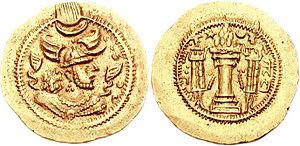Peroz I

Peroz I (Pirooz, Peirozes, Priscus, fr. 33; Perozes, Procop. Pers. I. 3 and Agath. iv. 27; the modern form of the name is Perooz, Piruz, or the Arabized Ferooz, Firuz), was the seventeenth Sassanid King of Persia, who ruled from 457 to 484. Peroz I was the eldest son of Yazdegerd II of Persia (438–457).
War of Succession
On the death of Peroz I's father, Yazdegerd II, the younger son of the deceased Emperor, Hormizd seized the throne in the absence of his elder brother Peroz who had been posted as the Governor of distant Sistan forcing Peroz to seek the protection of the Hephthalites. The Hephthalite monarch, Khush-Nevaz was only too glad to welcome him and aid him in his war against Hormizd. So, with Hephthalite assistance, Peroz led an army against Hormizd, defeated him and held him captive. Sources differ as to what happened to Hormizd after his capture. Some say that he was put to death. However, the Persian historian, Mirkhond says that Peroz pardoned his younger brother and amicably spared his life.
Reign
Peroz ruled from 457 to 484. He is said to have favored Nestorianism and persecuted Chalcedonians. Historians regard him as a fearless monarch and give him the epithet, Peroz the Victorious.
Events
The civil war in Persia had affected the nation so much as to cost a province. Vatche, the king of Aghouank (Albania), rebelled against Persian rule and declared himself independent while the brothers were busy fighting amongst each other. So once Peroz I ascended the throne in the year 457, he led an army into Albania and completely subjugated the nation. He then dismissed his allies the Hephthalites with costly presents and proceeded to rule the nation in moderation and justice.
The Seven Year Famine 464-471
Historians of the period record the occurrence of a seven-year famine which devastated the crops and ruined the country. Sources say that the wells became dry and that there was not a trickle of water either in the Tigris or the Euphrates. Eventually the crops failed and thousands perished.
Historians record that Peroz I showed an extreme rigidness of character in the face of such an adversity and great wisdom in dealing with the catastrophe. As a result of his wisdom and benevolence, Persia gradually recovered from the famine.
The First Campaign Against the Huns
No sooner had Persia recovered from the famine, than war broke out with the Huns of the north. Provoked by an insult heaped upon him by Khush-Newaz, Peroz led an invasion of the Hephthalite country forcing them to retreat. But when Peroz pursued the Hephthalites to the hills, he suffered a crushing defeat and was forced to yield to the Huns and pay them tribute. More importantly, he had to surrender his son Kavadh to Khush-Newaz as hostage.
Trouble in Armenia
In 481, Peroz was defeated by the Kushans. Soon afterwards, Iberia broke into revolt and declared its independence. Peroz sent the Persian Governor of Armenia to Iberia to quell the rebellion. But no sooner had he left the province, that Armenia rose in rebellion and chose an Armenian Christian called Bargatide as its Emperor.
The Persian Governor, Adar-Vishnasp after restoring Persian rule in Iberia rushed to Armenia to quell the rebellion but was squarely defeated. Peroz responded by sending two large armies to the region, one under Adar-Narseh into Armenia and the other against Iberia.
Sahag, the Armenian king, was killed and Mihran was wreaking havoc in Persia, but just when success was within grasp, Peroz blundered by recalling Mihran and entrusting the command to one Hazaravough. Hazaravough too did not remain long in Armenia and was recalled in a few months. This policy of rotating military commanders frequently ensured that Armenia was lost to the Persians for the time being.
The Second Campaign against the Huns and Peroz I's Death
Towards the end of his reign, Peroz gathered an army of 50,000-100,000 men and, placing his brother Balash at the head of the government in Ctesiphon, he invaded the Hephthalites in order to avenge the insult heaped upon him during the first campaign. He set up his position at Balkh and rejected the terms of peace offered by Khush-Newaz. However, when a showdown with the Persians seemed imminent, Khush-Newaz sent a small body of troops in advance in order to trick Peroz into an ambuscade. The plan was successful, and the Persians were defeated with great slaughter, Peroz being one of the victims. Khush-Newaz, however, treated the body of his erstwhile friend with dignity and dispatched it to Persia to be buried with full honors. Balash was crowned the next Emperor of Persia.
Soon afterwards, the Hephthalites invaded and plundered Persia. Persia, however, was saved when a noble Persian from the Parthian family of Karen, Zarmihr (or Sokhra/Sufra), raised Balash (484–488), one of Peroz I's brothers, to the throne.
References
- This article incorporates text from a publication now in the public domain: Chisholm, Hugh, ed. (1911). Encyclopædia Britannica (11th ed.). Cambridge University Press.
{{cite encyclopedia}}: Missing or empty|title=(help)
